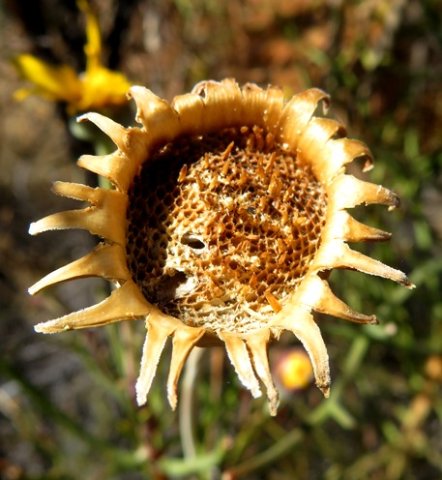Euryops speciosissimus pitted receptacle

Author: Ivan Lätti
Photographer: Thabo Maphisa
After a Euryops speciosissimus flowerhead has performed its procreative functions and the seeds are all dispersed, the little holes in the dry base of the receptacle floor indicate where the disc florets had been anchored.
Spread in a circle, the long-serving involucral bracts are still present, now recurved out of the way for impaired departures of the pappus-bearing seeds that took the wind. What happened to them all?
In Daisyworld the life of a sufficient number of seeds making it to one more generation, ensured by abundance allowed for in the reproduction system, trumps all concerns over individual plight in the numerous failed seeds and young plants that never flowered. To each his own, is the way species snuggle up in ecological niches, facing the ubiquitous survival challenge of life on earth together and thoroughly alone.
People invented counting that serves as a success measure. They apply it everywhere from counting beans to people in population census exercises and other statistics like the impact of pandemics, earthquakes, wars and pogroms.
Nicolai Gogol made satire in his 19th century novel, Dead Souls, about the greedy trade in death records of Russian serfs conducted in those days. Humanity uses humour to good effect in maintaining sanity in society, and thereby contributing to species survival, when facing some of the most dreadful threats to body and spirit.
All species work hard at survival matters, each in its own way; cognitively among people and some higher animals, organically and evolutionary among all, including people. The focus is on a balance between the tried and tested nature or way of species life, combined with adaptations, bold or imperceptible but vital.
The political germ, being torn between holding on to the known in comfort zones and embracing the new in taking risk, may be more deeply embedded and widely prevalent among living species than people think.
However lifes choices are made, there is always some missing information about the future, sure to turn up later and exact its price (Manning, 2007; iNaturalist; http://pza.sanbi.org).

